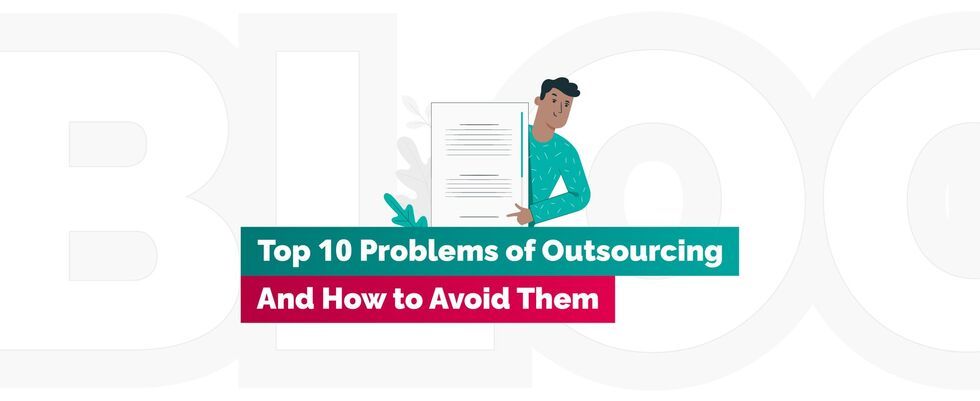Top 10 Outsourcing Problems and How to Avoid Them

Content Marketing Manager at TechMagic. Mainly focused on content marketing, SEO optimization, and media relations.

What are the most common problems of outsourcing and how to mitigate them? Experts name 10 issues they face with outsourcing and the best solutions.
There is a multitude of reasons why more and more companies choose to outsource some of their tasks. The primary reason is its cost-effectiveness, but access to a larger talent pool and general efficiency driven by the ability to focus on your primary goals also play major roles.
No wonder that according to Statista, the global market size of outsourced services in 2019 was $92.5 billion. However, if outsourcing were that flawless and did not pose any risks, we would not discuss the problems in outsourcing implementations. What are the most common problems you will face when outsourcing a task to a vendor, and how to avoid them?
Experts Name the Top 10 Problems of Outsourcing
Based on our in-depth experience, we have prepared a list of the top 10 problems that you might face when outsourcing your projects and how to avoid or overcome them.
Problem #1: Lack of Experience with Outsourcing
When you first start working with someone or at something, it might be overwhelming. You are not familiar with best practices, common concepts, the workflow. To convey your vision to another group of people, especially someone you have never worked with before is a difficult task that should not be underestimated.
Solution: choose an experienced vendor
An experienced vendor will walk you through the process, help you avoid the bottlenecks, and mitigate possible risks. They will help you define requirements, go through the discovery stage, and find the best people for the job. But at the end of the day, it is essential to remember that outsourcing is risky, and if it’s a risk you are willing to take, the right provider will be there to support you at every step.
Problem #2: Lack of Expertise with The Outsourced Task
Another problem with outsourcing is a lack of competence. When you do not have enough expertise in JavaScript software development or Big Data analytics and delegate these tasks to a third-party service, you probably will not be able to assess the results of their work adequately. Without having a clear understanding of the differences in technologies and solutions, you are at risk of mis-hiring or misjudging.
Solution: fill the knowledge gap
The most important part of avoiding this pitfall is setting clear performance standards for the project. You may want to hire someone in-house who would define requirements for tasks and monitor the vendor’s work more accurately. If you can’t afford another worker on your staff, be sure to find a vendor who will be knowledgeable and trustworthy enough to help you understand the workflow and results.
Problem #3: Poor Cost Estimate
Although we did say that outsourcing will save you a good portion of your budget, it may go south if not thoroughly planned. And you can’t estimate costs without establishing precise requirements, timelines, resources, etc. This brings us to one of the most challenging issues with outsourcing – calculating an accurate cost estimation.
Solution: set clear project requirements
If you are having trouble defining the exact set of requirements for the project, find an experienced firm or individual freelance workers who can help you with this task. Ask as many questions as you can think of to determine how the pricing model works to avoid unexpected charges. Explain your budget limitations to the vendor to minimize misunderstandings in the future.
Problem #4: Choosing the Right Vendor
Among other problems of outsourcing, you might face difficulty looking for a vendor of the right size. A small outsourcing company will leave you no room for growth as it will not easily scale up or down. An enterprise-sized outsourcing firm might take a less personal approach and charge you too much for your project.

Solution: find the middle ground
Take a step back and objectively assess your company: its size, number of employees, growth potential, revenue, brand awareness, etc. Do not go for a large outsourcing company if you are still in the startup phase. The money you would spend on it would be enough to cover a paycheck of an in-house specialist. At the same time, don’t choose the cheapest vendor on the market since it poses a greater risk of getting poor results.
Problem #5: Lack of Cultural Context
If you have never worked in a culturally diverse and dedicated development team, you might not realize it, but the cultural context and the national differences matter. Although diversity is proved to drive innovation and financial results in the long-term, in the beginning, it might lead to miscommunications and misunderstandings. On top of that, since you will be reaching out to the global market, you might have to get used to working with people from different time zones.
Solution: don’t underestimate the significance of cultural differences
This solution to the outsourcing problem goes in both ways: you could organize diversity awareness training programs for your staff as well as convey your values and norms to freelancers. Additionally, be sure to build clear communication channels and organize regular calls to bring everyone on the same page.
Problem #6: Contractual and Legal Processes
Unlike the in-house hiring process, the outsourcing legal process is not as standardized and depends a lot on the vendor’s location. From country to country, you might need to sign various additional papers that are not part of your location’s legal process. The outsourcing issues begin after the contracts have been signed and the work has started – small misunderstandings in the agreement might lead to serious outcomes that poison the entire dynamic between you and your vendor.
Solution: be scrupulous and exhaustive when it comes to legalese
Be sure to prepare an NDA for the outsourcing company to sign as well as other regulation documents if needed. Discuss every possible part of the process, including situations where your vendor fails to perform or messes up something, and do not forget to cover the security issues. Your contract should entail clauses about compensation, working conditions, freelancer’s responsibilities, ownership information, and other relevant things.
Problem #7: Poor Knowledge Transfer
Poor knowledge transfer delves into two outsourcing problems: the first one is from your perspective, the other is from the vendor’s point of view.
You might experience a negative outcome when dealing with the project results after the relationship with the vendor has been terminated. If they did not keep clear documentation, you might stumble upon some features or scripts unclear to you. On the other hand, if the vendor inherits an ongoing project from you with no transparent knowledge transfer procedure, they might fail to meet your expectations.
Solution: keep clear and extensive documentation
Make sure to create a detailed knowledge transfer plan: the features, technology, code logic. Your vendor should be able to grasp the project just by going through your documented regulations. If it is not enough, organize calls or meetings, if possible, with the outsourcing company, your DevOps specialists, QA automation engineers, and developers to discuss hidden pitfalls and answer all the questions your vendor might have.
Problem #8: Poor Team Management and Communication
It might sound like a broken record, but communication is the key to success. You might think that you are being understood the way you planned, but people come from different backgrounds, educations, and experiences and will have their own perceptions. If you do not wish to be misinterpreted and agree that an adequate communication level will smooth many rough edges, here are our solutions to outsourcing jobs.

Solution: implement continuous communication
Make sure to make communication an important part of the workflow – integrate calls, feedback loops, and other communication techniques into your project schedule. If possible, you can also visit each other’s offices to have in-person meetings that facilitate better understanding and increase the level of empathy. Finally, use project management tools like JIRA and Trello to be in-sync with each other and create a shared GitHub board to share technical processes.
Problem #9: Finding a Trustworthy Vendor
One of the most common reasons for outsourcing gone wrong is partnering up with an unsuitable agency. We have mentioned several times the importance of tracking a trustworthy vendor. But what does it really mean? How do you tell one from another?
Solution: do your due diligence
Sometimes the information you will find online is highly inconsistent where one website will have solely positive reviews and another a bunch of negative comments. Check reliable resources like Clutch, TopDevelopers, DesignRush, and visit vendors’ homepages to read about their cases and experience.
Problem #10: Selecting the Appropriate Outsourcing Approach
There are three common outsourcing models:
- Time and material model;
- Fixed-price contracts;
- Dedicated development teams.
Depending on your goals, requirements, scope, duration, budget, and other criteria, you may choose one of the models. How do you choose?
Solution: read our tips below
- The fixed price model requires you, as a client, to provide the full list of requirements for the project, in other words, scope, and set the exact deadline & budget. Unfortunately, due to the inflexibility, outsourcing teams are sometimes forced to drop a few features to make it in time. Or it might shift the opposite way, and you will have to pay extra fees for developers’ work because of unexpected changes.
- The time and material model is an approach better suited for long-term partnerships and allows for changes on-the-go. With this model, you pay only for the features that have actually been added and avoid extra costs and poor results.
- Dedicated development teams are basically extra workers on your team that fill in a knowledge gap. Instead of completely delegating your project, you will still be in charge and have more short-term experts on your team.
Golden Rules to Avoid Problems of Outsourcing

Let’s revisit all the tips above:
- Keep track of the documentation
- Establish direct communication channels
- Be aware of cultural differences
- Always conduct thorough research before deciding on a vendor
- Clearly define the requirements, duration, and costs of the project
- Make sure you understand the risks and find the company that you trust.
Conclusion
If outsourcing is new to you, you probably will face some challenges first, which is why it is so important to choose an agency that you can trust. A reliable outsourcing vendor is a company with enough cases that prove their expertise, positive feedback from their clients, and a devoted team of professionals who will be there to walk you through each step.
TechMagic is a software product development company with a strong background in JavaScript, AWS, and web app development services. Our mission is to build you a dedicated team of experts and deliver the best product.
Interested to learn more about TechMagic?
Contact usWe have worked with many technologies in the book – Node.JS, TypeScript, Angular, Swift, Kotlin, and others. If you feel like you need a trustworthy agency to fill some skill or knowledge gaps, contact our team of specialists who will be happy to answer your questions and help you at every step of the outsourcing process.



 Software Development
Software Development
 Security Services
Security Services
 Cloud Services
Cloud Services
 Other Services
Other Services
















 TechMagic Academy
TechMagic Academy
 linkedin
linkedin
 facebook
facebook
 twitter
twitter






















